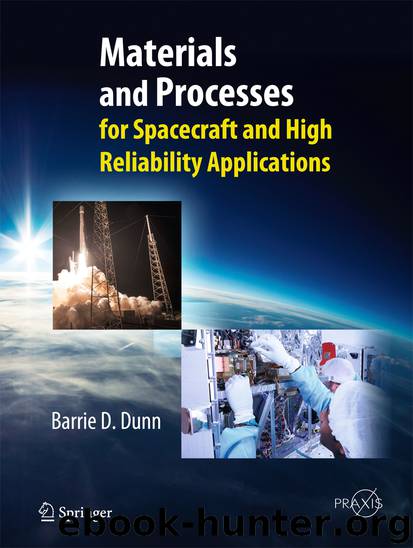Materials and Processes by Barrie D. Dunn

Author:Barrie D. Dunn
Language: eng
Format: epub
Publisher: Springer International Publishing, Cham
5.15.4 Removal of Silicone Polymers
It is generally difficult to completely remove liquid silicones from metallic surfaces.
In the case of uncured liquid it is advisable to begin cleaning before any polymerization takes place. This takes place quickly when the liquid is in contact with air. White spirit is quite effective; it has a high flash point and is not very volatile. Experts advise that wiping with a cloth soaked in isopropyl alcohol (IPA) gives the best results. As IPA is flammable, benzyl alcohol is an alternative but is slightly toxic.
Fluorosilicones, being a separate family of materials, require the use of polar solvents. Here, methyl isobutyl ketone or methyl ethyl ketone is recommended.
Methylene chloride may be suitable to remove cured low molecular silicones.
Other, cured solid silicones may be mechanically removed by peeling [this is possible for some conformal coatings (Dunn and Desplat 1994)].
Two special removal agents are also available: DIGESIL from C&M Research Ltd., Enfield, UK (or from Merck in other countries), and
Download
This site does not store any files on its server. We only index and link to content provided by other sites. Please contact the content providers to delete copyright contents if any and email us, we'll remove relevant links or contents immediately.
| Automotive | Engineering |
| Transportation |
Whiskies Galore by Ian Buxton(41522)
Introduction to Aircraft Design (Cambridge Aerospace Series) by John P. Fielding(32880)
Small Unmanned Fixed-wing Aircraft Design by Andrew J. Keane Andras Sobester James P. Scanlan & András Sóbester & James P. Scanlan(32565)
Craft Beer for the Homebrewer by Michael Agnew(17925)
Turbulence by E. J. Noyes(7689)
The Complete Stick Figure Physics Tutorials by Allen Sarah(7133)
Kaplan MCAT General Chemistry Review by Kaplan(6582)
The Thirst by Nesbo Jo(6431)
Bad Blood by John Carreyrou(6268)
Modelling of Convective Heat and Mass Transfer in Rotating Flows by Igor V. Shevchuk(6217)
Learning SQL by Alan Beaulieu(6023)
Weapons of Math Destruction by Cathy O'Neil(5816)
Man-made Catastrophes and Risk Information Concealment by Dmitry Chernov & Didier Sornette(5637)
Digital Minimalism by Cal Newport;(5376)
Life 3.0: Being Human in the Age of Artificial Intelligence by Tegmark Max(5179)
iGen by Jean M. Twenge(5149)
Secrets of Antigravity Propulsion: Tesla, UFOs, and Classified Aerospace Technology by Ph.D. Paul A. Laviolette(4971)
Design of Trajectory Optimization Approach for Space Maneuver Vehicle Skip Entry Problems by Runqi Chai & Al Savvaris & Antonios Tsourdos & Senchun Chai(4836)
Electronic Devices & Circuits by Jacob Millman & Christos C. Halkias(4738)
